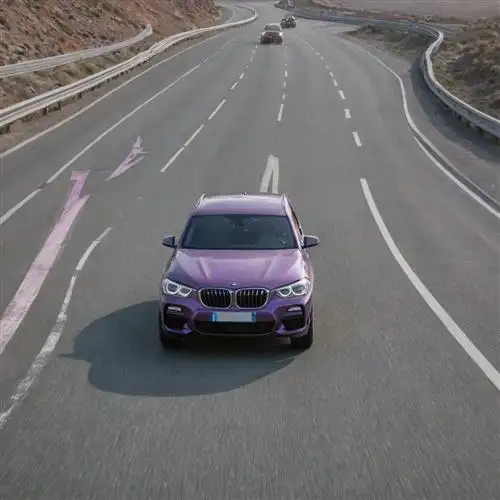
Comprehensive Airbag System
The BMW X3's comprehensive airbag system is a testament to the brand's commitment to safety. This advanced system features a total of up to ten airbags, including front airbags, side airbags, and curtain airbags, providing all-around protection for the driver and passengers. The front airbags are designed to deploy with variable force, ensuring a tailored response based on the severity of the collision and the specific needs of the occupants.
The side airbags, located in the front seat backrests, are designed to safeguard the upper body in the event of a side impact. Meanwhile, the curtain airbags, which deploy from the roof frame, offer protection for the head and upper body in both front and rear seats. This comprehensive coverage helps to mitigate the risk of serious injury in the event of a collision.
But the BMW X3's airbag system goes beyond just the number of airbags. It also features advanced sensors that continuously monitor the vehicle's dynamics and the occupants' positions, ensuring the airbags deploy with the optimal force and timing. This intelligent system can even detect if a child seat is present and adjust the airbag deployment accordingly, further enhancing the safety of the vehicle's youngest occupants.
Intelligent Braking Technology
Intelligent Braking Technology is a vital component of the BMW X3's comprehensive safety system. This advanced feature utilizes a range of sensors and computerized systems to enhance the vehicle's braking capabilities, providing drivers with enhanced control and greater peace of mind on the road.
At the heart of the BMW X3's Intelligent Braking Technology is the Anti-lock Braking System (ABS), which prevents the wheels from locking up during heavy braking. This system continuously monitors the speed of each wheel and adjusts the brake pressure accordingly, ensuring that the tires maintain traction and the vehicle remains stable and responsive. The result is shorter stopping distances and improved maneuverability, even in challenging driving conditions.
Complementing the ABS is the Dynamic Stability Control (DSC) system, which further enhances the X3's braking capabilities. DSC continuously monitors various vehicle parameters, such as steering angle, yaw rate, and lateral acceleration, and automatically applies individual wheel brakes to counteract understeer or oversteer. This helps the driver maintain control of the vehicle, particularly during sudden lane changes, sharp turns, or when driving on slippery surfaces.
The BMW X3's Intelligent Braking Technology also includes features such as Cornering Brake Control (CBC) and Hill Descent Control (HDC). CBC optimizes brake pressure distribution across the wheels during cornering, ensuring that the vehicle remains stable and responsive even when negotiating tight turns. HDC, on the other hand, allows the driver to maintain a controlled descent on steep inclines, without the need for constant brake application.
One of the standout features of the BMW X3's Intelligent Braking Technology is the Brake Drying function. This system automatically applies a light braking force to the discs when the windshield wipers are in use, keeping the brake pads dry and ready for immediate, full-power braking in wet conditions. This can significantly reduce stopping distances and enhance the driver's ability to react quickly to changing road conditions.
Additionally, the BMW X3 is equipped with Adaptive Brake Lights, which illuminate the brake lights more brightly when the driver applies the brakes with greater force. This feature helps alert following drivers to the vehicle's braking status, potentially reducing the risk of rear-end collisions.
Adaptive Cruise Control
The BMW X3's Adaptive Cruise Control system is a cutting-edge feature that dramatically improves both safety and driving experience. This intelligent system uses radar sensors to constantly monitor the vehicles ahead, automatically adjusting your X3's speed to maintain a safe following distance. Unlike traditional cruise control, Adaptive Cruise Control can bring your vehicle to a complete stop in traffic and then resume driving when the car ahead moves, making it an indispensable tool for navigating congested highways and stop-and-go traffic.
One of the key benefits of Adaptive Cruise Control is its ability to reduce driver fatigue on long journeys. By automatically maintaining a safe distance from the vehicle in front, the system allows you to relax and focus on steering, while still keeping your X3 at a safe and legal speed. This is particularly useful during extended highway driving, where traditional cruise control would require the driver to constantly adjust the speed to account for changing traffic conditions.
But Adaptive Cruise Control is more than just a convenience feature – it's a powerful safety tool that can help prevent collisions. The system's radar sensors can detect vehicles up to 650 feet (200 meters) ahead, and it will automatically apply the brakes if it senses the car in front of you is slowing down or stopping unexpectedly. This can provide valuable reaction time and help you avoid rear-end collisions, one of the most common types of accidents on the road.
Another notable feature of the BMW X3's Adaptive Cruise Control is its ability to integrate with other advanced driver assistance systems, such as Lane Departure Warning and Forward Collision Warning. By working in tandem, these systems can create a comprehensive safety net that monitors your vehicle's surroundings and intervenes when necessary to help keep you and your passengers safe.
Dynamic Stability Control
Dynamic Stability Control (DSC) is a vital safety feature in the BMW X3, engineered to enhance the vehicle's stability and control in various driving conditions. This advanced system continuously monitors the car's movement, comparing its actual path to the driver's intended direction. When the system detects a loss of traction or the vehicle beginning to drift off course, it automatically applies individual wheel braking and adjusts engine power to bring the vehicle back in line, preventing skids and improving handling.
At the heart of DSC is a complex network of sensors that track the X3's speed, steering angle, yaw rate, and wheel speeds. This data is constantly analyzed to identify any discrepancies between the driver's inputs and the vehicle's actual behavior. When the system identifies a potential loss of control, it springs into action, selectively braking individual wheels to generate a corrective force and restore stability.
One of the key benefits of DSC in the BMW X3 is its ability to enhance the vehicle's cornering capabilities. By monitoring the car's trajectory through corners and detecting any tendencies to understeer or oversteer, the system can apply precise braking to individual wheels, effectively pivoting the X3 around the turn and ensuring a smooth, controlled path.
DSC also plays a crucial role in maintaining stability on slippery surfaces, such as wet or icy roads. In these conditions, the system can detect the onset of wheel slip and immediately intervene, reducing engine power and applying brakes to prevent the wheels from losing traction. This helps the X3 maintain its composure and allows the driver to retain full control of the vehicle, even in challenging weather conditions.
Moreover, DSC integrates seamlessly with other BMW safety technologies, such as the Anti-lock Braking System (ABS) and Cornering Brake Control (CBC), to provide a comprehensive suite of stability and control features. This synergistic approach ensures that the BMW X3 remains poised and responsive, even when faced with demanding driving scenarios.
Blind Spot Monitoring
Blind Spot Monitoring is a cutting-edge safety feature that has become increasingly common in modern vehicles, including the BMW X3. This innovative technology aims to enhance driver awareness and prevent potentially hazardous lane-change maneuvers. By constantly monitoring the areas adjacent to the vehicle, Blind Spot Monitoring systems can detect the presence of other cars, motorcycles, or even pedestrians that may be lurking in the driver's blind spots.
When a vehicle or object is detected in the blind spot, the system typically provides a visual alert, such as an indicator light in the side-view mirror or a discreet icon on the dashboard. In some cases, the system may also emit an audible warning to further grab the driver's attention. This real-time feedback allows the driver to make a more informed decision before changing lanes, ultimately enhancing overall safety and reducing the risk of collisions.
One of the key benefits of Blind Spot Monitoring is its ability to compensate for the inherent limitations of the human visual system. Even the most attentive drivers can have trouble fully accounting for their vehicle's blind spots, especially when maneuvering in heavy traffic or during poor weather conditions. By automating this monitoring process, Blind Spot Monitoring systems can help drivers stay vigilant and make safer lane-change decisions.
Moreover, the integration of Blind Spot Monitoring with other advanced safety features, such as Lane Departure Warning and Rear Cross-Traffic Alert, can create a comprehensive safety net for BMW X3 drivers. This synergy of technologies allows for a more holistic approach to accident prevention, providing an additional layer of protection for both the driver and other road users.
When it comes to the practical implementation of Blind Spot Monitoring in the BMW X3, the system typically utilizes radar sensors or cameras mounted on the rear quarter panels of the vehicle. These sensors continuously scan the adjacent lanes, constantly updating the driver on the presence of nearby vehicles or obstacles. The system's algorithms are designed to differentiate between genuine threats and false positives, ensuring that the driver receives only the most relevant and actionable alerts.
















